
ICCROM_ICS11_History_en
.pdf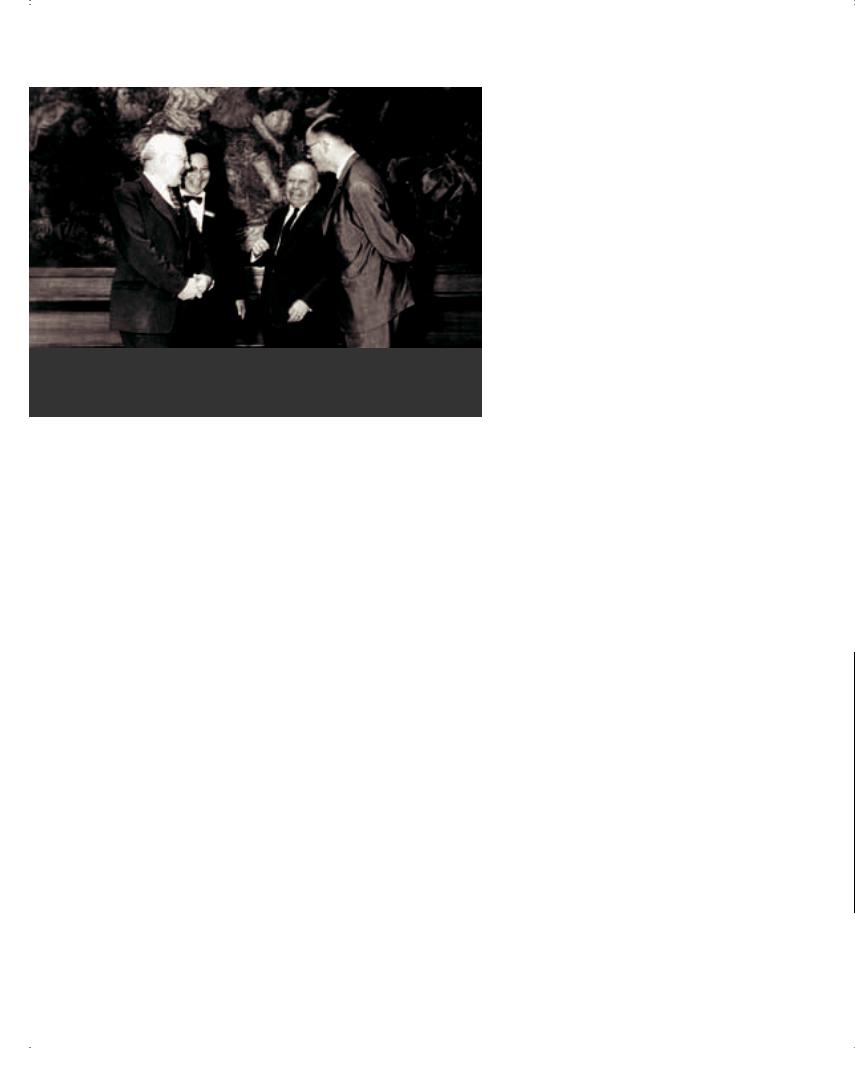
Figure 2-6
(From left) H.J. Plenderleith, Hiroshi Daifuku, Stanislaw Lorentz and Hugues de Varine in ICOMOS’ founding conference in Krakow, 1965
direction is in agreement. Architects, instead, are each of them a small company, which means a very different spirit. This explains, I believe, the great difference between ICOMOS and ICOM, a part from architecture that in itself is very different from collections. Rivière was very able in giving stimuli both as an organizer and giving ideas of possible links with ICOM. The successor of Rivière was Hugues de Varine; he was about my age, very dynamic and with him we could continue a close collaboration. Considering that ICOM had its premises at UNESCO, he was very useful also in keeping in touch with UNESCO. I found the contacts with Varine much easier than with Hiroshi Daifuku, who then represented UNESCO. He was a rather difficult person in my mind.”58
(c) Programme development
For the Secretariat the start of a new organization was not immediately clear and straightforward as they explored the situation in the world, and prepared a programme of activities and projects in response to emerging needs. Philippot has described the initial atmosphere as follows:
“At the beginning, Dr. Angle had to do the administration, but it was not congenial for him. He was not so well organized in such work, but he was very learned: he had solid education in classical philology, he knew a lot about philosophy, the literature, a Polish, actually, Italian-Polish, Italo Carlo Angle. He took his
pipe, and we continued chattering for hours. It was magnificent to discuss Heidegger with Angle, and to drink tea in the afternoon. Angle could read in many languages; his English was a bit awkward, but he managed. His French was very good, but not quite enough to write perfect documents. For this reason, the Council asked me to produce all the reports, and so I did. As a practical necessity, I had to establish an internal structure for such documents, and this remained valid for many years. The personnel continued developing little by little. Another person to join the staff was Giulio Catena, who was responsible for accountancy.”59
(d) Consultations and missions
In October 1959 the Director-General of UNESCO invited the Director of the Centre to take part in an international meeting of experts “with the object of devising suitable means for safeguarding such Nubian sites and monuments as were threatened with submersion by the construction of the new Aswan dam.”60 This was the first occasion for the Centre to be publicly acknowledged as an authority. UNESCO also consulted the Centre on the conservation of wall paintings in Mexico and in Thailand.
During the first year of activity, Director Plenderleith undertook two important missions. The first one took him, following the ICOM Stockholm Conference, to Finland, USSR and Poland. He noted, for example, that Finland had only four trained restorers at the time, while one hundred ancient churches required frequent action during the long winter months - not to speak of problems on archaeological sites. In his second mission he went to Nubia, Lebanon, Syria and Jordan, where he visited archaeological museums and laboratories, discussing specific problems of conservation. In Poland, the Director visited several reconstruction sites. The missions by the Director of the Centre were fundamentally important in order to make the organization known to as many countries as possible, but also to acquire firsthand information on the challenges, problems, and resources that existed in the different national realities.
(e) Publications
The close collaboration between ICOM and the Rome Centre made it possible to publish an International Inventory of Museum Laboratories and Restoration Workshops, which was proposed to be kept up-to-date by the Centre for periodic reprinting. In the same year Museum (vol. XIII, No. 4, 1960) published a monograph on Climatisation dans les Musées written by Plenderleith and Philippot, based
20 |
ICCROM and the Conservation of Cultural Heritage. A history of the Organization’s first 50 years, 1959-2009 |
|
|
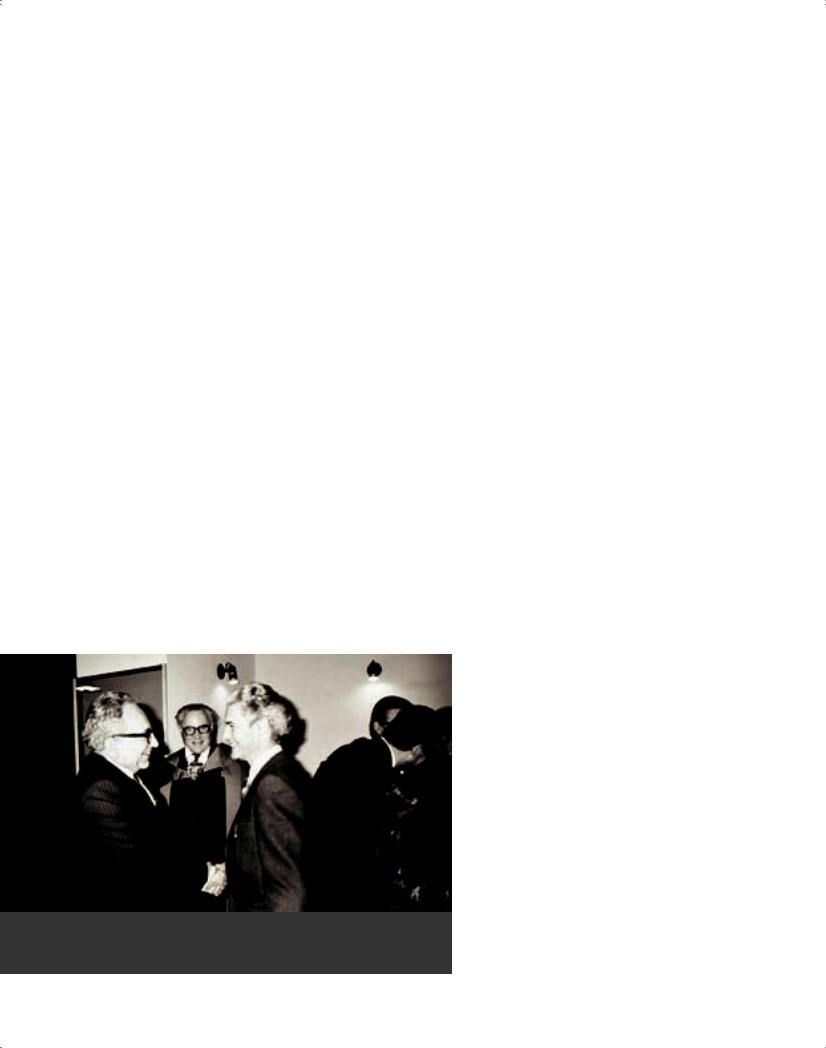
on a collaborative study with ICOM. Also in collaboration with ICOM, the Centre was invited to take part in a study of mural paintings, The Conservation of Mural Paintings in Different Countries: Report on the General Situation. Finally, it gave attention to the training of personnel for the vocation of restorer, resulting in an article published in the IIC’s Studies in Conservation.61 Alongside these efforts, Philippot reserved time for translating into French Plenderleith’s chef d’oeuvre, The Conservation of Antiquities and Works of Art (1956).
(f) Documentation and abstract service
Regarding documentation, the Centre had the major task of gathering together and classifying methodically and comprehensively documentation suitable for study and dissemination. It devised a system of classification based partly on an analytical arrangement and partly on a complementary drafting of ‘excerpts’, which would make it possible “to collect quickly all information related to a given subject whether it be related to some craft or technique or be concerned with some preservation problem.”62 It contacted IIC about collaborating on preparing abstracts of scientific publications. The Centre was also planning a service to provide photocopies of documentation to professionals in Member States, working in collaboration with ICOM and IIC.
As the 1960 Report on Activities by the Provisional Council noted, the Centre was already receiving visits from conservation experts from the different world regions, from European countries as well as from North and Latin America, Asia, Australia, New Zealand, Ghana and Afghanistan.
Figure 2-7
Italo Carlo Angle (left) and Paul Philippot (Bernard Feilden in background; photo 1977)
The report mentions a visit by John Marshall of the Rockefeller Foundation to examine the problems related to the conservation of furniture and paintings in Villa Serbelloni on Lake Como.
(g) Aims for the future
The same Report by the Provisional Council ended with a summary of the future aims of the Centre as envisaged in Article 1 of its Statutes. Accordingly, the Centre had to:
•“Collect, study and diffuse documentation concerning scientific and technical problems in conservation;
•Publish up-to-date information on matters of common concern, and distribute free or at cost price;
•Coordinate, stimulate and sponsor research and encourage meetings and interchange of ideas;
•Advise and make recommendations, to set up conservation services and develop methods for treatment;
•Contribute to training of research students and technicians to attain higher standards in restoration;
•Formulate research programmes and referee granting of scholarships;
•Organize short missions to support countries on specific problems;
•Act as scientific advisors to UNESCO and inform on possibility to send expert missions.”
It noted that the gradual evolution and expansion of the Centre would ultimately depend on the interest of countries in becoming Members and contributing to this new undertaking.
“A skeleton team is in existence in Rome that has faith in its ideals of self sacrifice in the service of construction; in the conservation of all that is worthwhile in art, archaeology and culture generally. UNESCO is at present largely responsible for this. It is for the nations to decide whether or not the idea of a world centre for studies in conservation is premature or whether by its acts the Rome Centre has merited their support.”63
This first period forms, as it were, a ‘preface’ to the activities of ICCROM. Plenderleith and Philippot established the first policies in close collaboration with a number of internationally renowned experts and institutions, such as ICOM, IIC and UNESCO. It is from these beginnings that ICCROM started working in the 1960s and 1970s, decades that saw the foundations of the organization effectively built upon and future strategies developed.
2 The foundation of ICCROM |
21 |
|
|

3
The Rome Centre (1960-1970)
International context
During the emergency phase of post-war recovery in the 1950s, questions were raised about what and why to conserve, restore and/or reconstruct. The need for an international centre to coordinate research was one of the principal reasons for the establishment of the Rome Centre. In the 1960s the broader questions came up, and the first General Assembly of the Rome Centre discussed issues related to the consolidation of monuments, legislation and administration for the protection of the cultural property, and others related to urbanism and the conservation of archaeological areas and landscapes.64
An important initiative of UNESCO lay in preparing and having adopted by its member states standard-setting instruments, since these could serve as a focus for co-ordinating the ethical, normative and intellectual issues of international debate and fostering mutual understanding of common issues and principles of safeguarding. As regards Conventions, UNESCO had already adopted the Hague Convention (1954) regarding the protection of cultural property in the case of armed conflicts and this was followed in 1970 by the Convention on the Means of Prohibiting and Preventing the Illicit Import, Export and Transfer of Ownership of Cultural Property. A series of Recommendations adopted by Member States began with the Recommendation concerning archaeological excavations (1956). In the 1960s, the scope of its recommendations was enlarged to include accessibility of museums (1960), safeguard-
ing the beauty and character of landscapes (1962), prohibiting and preventing illicit export, import and transfer of ownership of cultural property (1964), and the preservation of cultural property endangered by public or private works (1968). This latter recommendation resulted from UNESCO’s experience of the international campaign to safeguard the Nubian monuments, its first major international campaign in which the Rome Centre was also directly involved from the start in 1959.
The international rescue campaign in Egypt and Sudan was formally launched in 1960, and was to last for twenty years in its efforts to save the monuments and sites that were to be flooded by the Aswan High Dam. This was the first and largest in a series of international campaigns which have included Mohenjo-Daro (Pakistan), Fez (Morocco), Kathmandu (Nepal), Borobudur (Indonesia), the Cultural Triangle of Sri Lanka, Venice in Italy, and the Acropolis of Athens.
The normative action by UNESCO contributed to the consolidation of conservation policies in a period when the legal frameworks and theory of con- servation-restoration were evolving at the national level. For example, the 1960s saw new legislation in the UK regarding conservation areas (1967), and in France for secteurs sauvegardés (the Malraux Law of 1962). In Italy, the Istituto Centrale del Restauro
(ICR) had started training of restorers in the 1950s. The founding Director of the ICR, Cesare Brandi, brought together his writings regarding the modern theory of restoration in a publication that appeared in
22 |
ICCROM and the Conservation of Cultural Heritage. A history of the Organization’s first 50 years, 1959-2009 |
|
|
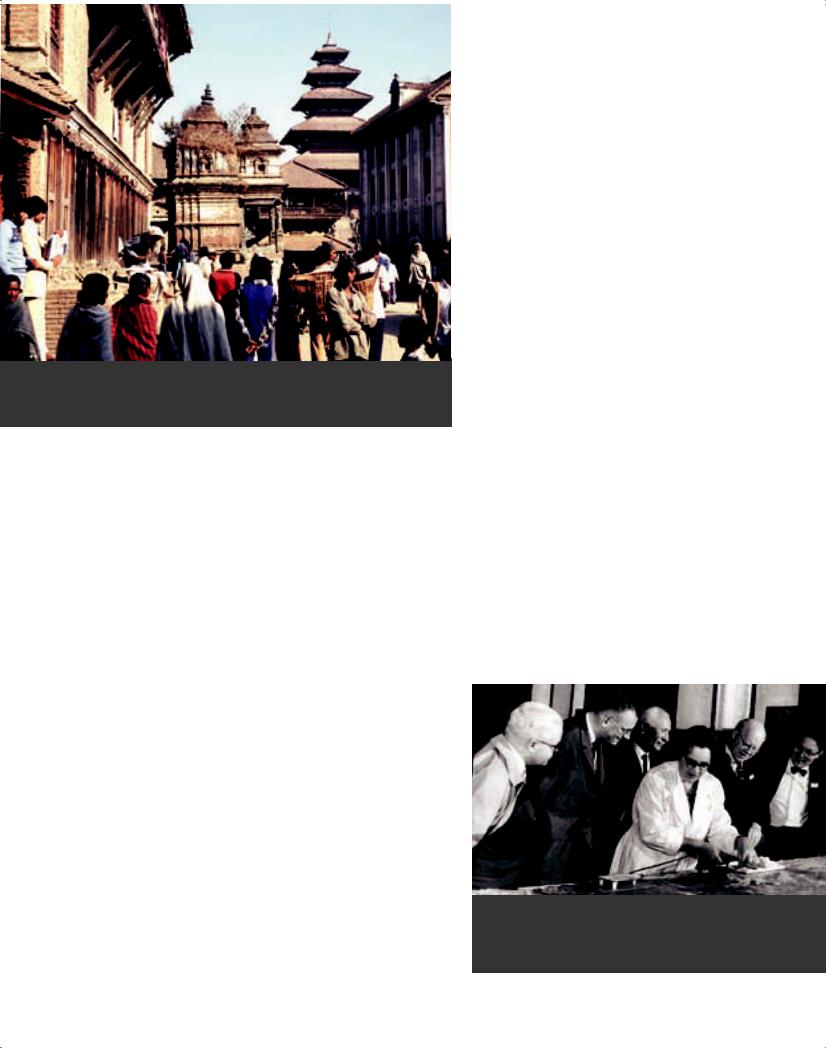
Figure 3 1
Bhaktapur, Kathmandu Valley (Nepal), object of a UNESCO International Safeguarding Campaign
1963.65 This theory became a fundamental reference for the Venice Charter that resulted from the Second International Congress of Architects and Technicians of Historic Monuments held in Venice in May 1964, where the Rome Centre was one of the principal protagonists.
Another recommendation of the Venice meeting was to establish an international non-governmen- tal organization, the International Council on Monuments and Sites (ICOMOS), and for it to collaborate closely with UNESCO, ICOM and the Rome Centre. ICOMOS was duly founded the following year at Krakow in Poland where Piero Gazzola was elected Founding President and Raymond Lemaire the General Secretary.66 Subsequent General Assemblies adopted particular themes: the Second General Assembly in Oxford in 1969 chose ‘Value for Tourism of the Conservation and Presentation of Monuments and Sites’: the Third in Budapest in 1972 ‘Modern Architecture in Historic Ensembles and Monuments’; and the 4th in Rothenburg (Germany) in 1975 the conservation of small towns.
The ICOMOS Documentation Centre was created at the initiative of UNESCO in 1965, in order: “to gather, study and disseminate information concerning principles, techniques and policies for the conservation, protection, rehabilitation and enhancement of monuments, groups of buildings and sites” (ICOMOS Statutes, Art. 5b). It became operational only in 1977 when ICOMOS hired a documentalist and an assistant to organize and manage it.
Administration of the
Rome Centre
Member States and the budget
The first General Assembly of the Member States of the newly established Rome Centre took place in Rome from 14 to 16 December 1960. By then 22 States had become Members.67 By the end of 1964, Member States had increased to 38, by January 1967 to 48 and, by the end of the first decade in 1971, the Rome Centre had 51 Member States. In terms of the finances, the increasing number of Member States did not in itself necessarily make a major difference in the budget, considering that most of the States contributed relatively small sums, a few hundred dollars (US). From 1959 to 1962, UNESCO contributed US $12 000 per year; in 1963-64, this was reduced to US $10 000 per year. From this time on, the Centre’s budget was based on contributions by Member States. Measuring the relative value of the dollar, calculated on nominal GDP per capita, the budget in 2008 values would have been approximately as indicated below:
•1960
UNESCO: US $12 000, Member States US $148 241
•1962
UNESCO: US $12 000, Member States US $176 261
•1964
UNESCO: US $10 000, Member States US $387 234
•1971
UNESCO: US $0, Member States US $973 111
It can be observed that there was a nominal increase from 1960 to 1962 of ca. 17.5%, from 1962 to 1964 of ca. 111.0%, and from 1964 to 1971 of
Figure 3 2
Laboratory visit during the ICOMOS Founding Conference, Krakow, 1965. From left: unidentified, H. de Varine,
G. Massari, H.J. Plenderleith and H. Daifuku
3 The Rome Centre (1960-1970) |
23 |
|
|

ca. 145.0%. In reality, this increase in budget was |
|
|
|
the result of some major contributors becoming new |
The General Assembly elected the following |
||
Member States. In 1964 these included France and |
five persons to the first Council in 1960: |
||
the Federal Republic of Germany; in 1967, Japan |
|
|
|
and the United Kingdom; and finally in 1971, the |
• |
Gertrude Tripp (1960-1969), Staatskonservator, |
|
USA. Thanks to these contributions the Rome Centre |
|
Bundesdenkmalamt, Vienna (Austria) |
|
could start a new phase of development from 1971 |
|
|
|
onwards. Until then, the financial resources strictly |
• |
Frédéric Gysin (1960-1967), former Director of |
|
limited any increase in personnel and activities. At |
|
the Musée National Suisse, Zurich (Switzerland) |
|
the same time, however, during the 1960s the Centre |
|
and President of the Consul Committee of ICOM; |
|
had been able to lay the strategic foundations for its |
|
|
|
future development. |
• |
Stanislaw Lorentz (1960-1970), Director-Gener- |
|
The first regular Council (1960) |
|
al of the National Museums, Warsaw (Poland) |
|
|
|
||
“The members elected by the General Assembly shall |
• |
Ahmed Sefrioui (1960-1963), Head of the |
|
be chosen from amongst the best-qualified experts |
|
Service of Historical Monuments, the Arts and |
|
concerned with the preservation of cultural property |
|
Folklore, Rabat (Morocco); |
|
and kindred scientific subjects. The members elected |
|
|
|
by the General Assembly must all be of different |
• Arthur van Schendel (1960-1974) Director- |
||
nationalities. They shall be elected for a term of |
|
General of the Rijksmuseum, Amsterdam (The |
|
two years, and shall be immediately eligible for re- |
|
Netherlands). |
|
election.” (Statutes, art. 7) |
|
|
|
|
|
|
Gysin was elected the first President of the |
|
|
|
|
AccordingtotheprovisionsoftheStatutes,the |
Council. When he retired in 1967, he was succeeded |
||
Council was to consist of nine members. Four |
by Lorentz. The Provisional Council had already |
||
were ex-officio members, already foreseen |
made it possible to establish an administrative and |
||
by UNESCO in the Provisional Council, who |
financial structure for the Centre and links with other |
||
represented partner organizations: |
organizations, such as UNESCO, ICOM and IIC. |
||
|
|
Even though the Italian Government had seconded |
|
•A representative of the Director-General of some personnel to the Centre, staffing questions UNESCO: Jan Karel van der Haagen (first were not solved immediately but continued over
session of the Council), Hiroshi Daifuku the years. For example, in May 1964, Plenderleith (second session), Giorgio Rosi (third session); had to write a strong letter to Piero Gazzola, as representative of Italy in the Council, complaining
•The Director of the Istituto Centrale del Restauro of the risk that the staff might be recalled and of the
(ICR), Rome: Cesare Brandi (1st session of |
continuing lack of the diplomatic status promised for |
the Council), Pasquale Rotondi (2nd and 3rd |
the Director.68 Gazzola took immediate action and |
sessions); |
reassured Plenderleith.69 In an interview, Gertrude |
|
Tripp, the youngest member of the Council, has |
• The Director of the Laboratoire Central des |
recalled the atmosphere of the first Council:70 |
Musées, Belgium (later IRPA): Paul Coremans; |
|
|
“In the Council, we had a few persons who were |
• A representative of the Italian Government: |
really much better prepared than average. It was |
Piero Gazzola, Chief Inspector of Fine Arts, and |
not just wise thinking, but it was more than |
Superintendent of Monuments at Verona; |
that. Coremans was an extremely clever man. |
|
Though he came from a laboratory, he had |
• Five members to be elected by the General |
a wide perspective, and he really understood |
Assembly. According to the Statutes (art. 7), the |
everything. Obviously we also had the people |
members were to be elected on the basis of their |
of the Istituto del Restauro, Cesare Brandi, P. |
professional qualifications and not as regional |
Rotondi, Giovanni Urbani; it was really a great |
representatives. |
moment (Sternstunde). I could not imagine the |
|
same to take place today. These people were |
|
somehow fanatic, but not in the negative sense; |
|
24 |
ICCROM and the Conservation of Cultural Heritage. A history of the Organization’s first 50 years, 1959-2009 |
|
|
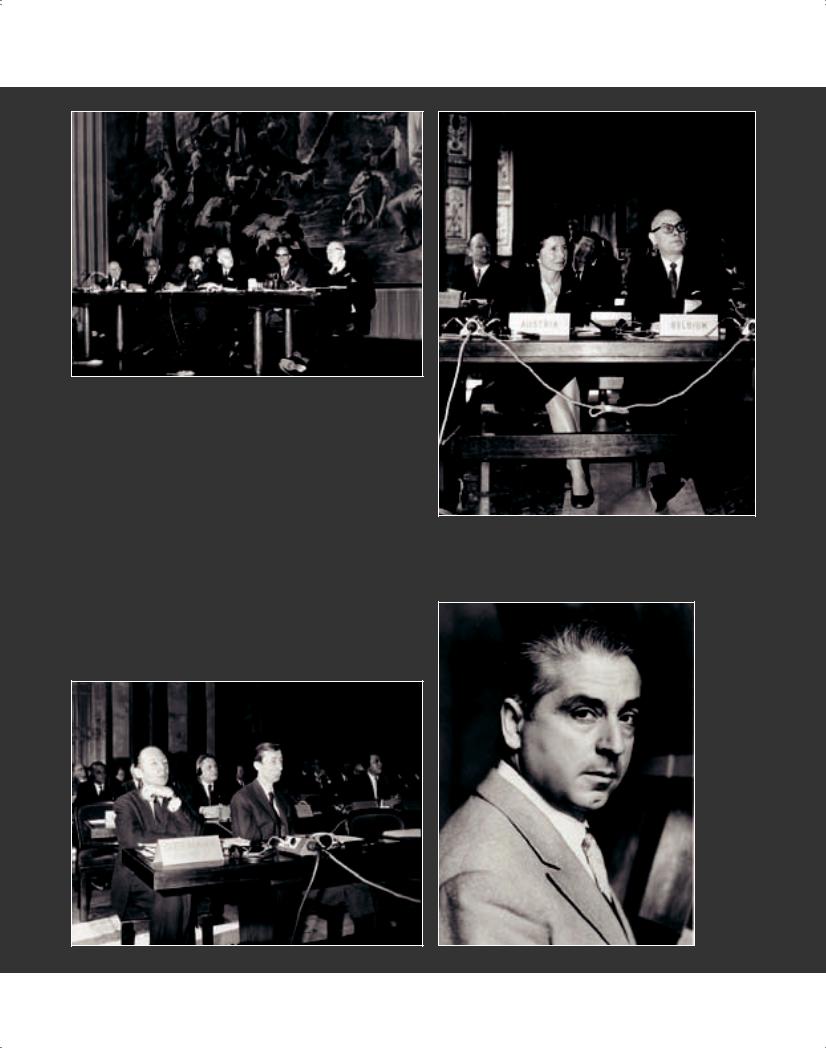
Figure 3 3 (LEFT TOP)
ICCROM General Assembly in Venice 1969; in the picture: Stanislaw Lorentz (Poland; President of Council); Totaram Gairola (India; member of Council), unidentified, Arthur van Schendel (Netherlands, Vice President of Council); Peyo Berbenliev (Bulgarian delegate); H.J. Plenderleith (UK, Director)
Figure 3 4 (LEFT BOTTOM)
ICCROM General Assembly in Venice 1969; Werner Bornheim gen. Schilling (German delegate) and Johannes Taubert (Germany, member of Council)
Figure 3 5 (RIGHT TOP)
Gertrude Tripp (Austria), René Sneyers (Belgium), members of Council
Figure 3 6 (RIGHT BOTTOM)
Cesare Brandi, the first Director of ICR, Rome, and author of an authoritative treatise on the theory of modern restoration (photo V. Rubiu)
3 The Rome Centre (1960-1970) |
25 |
|
|
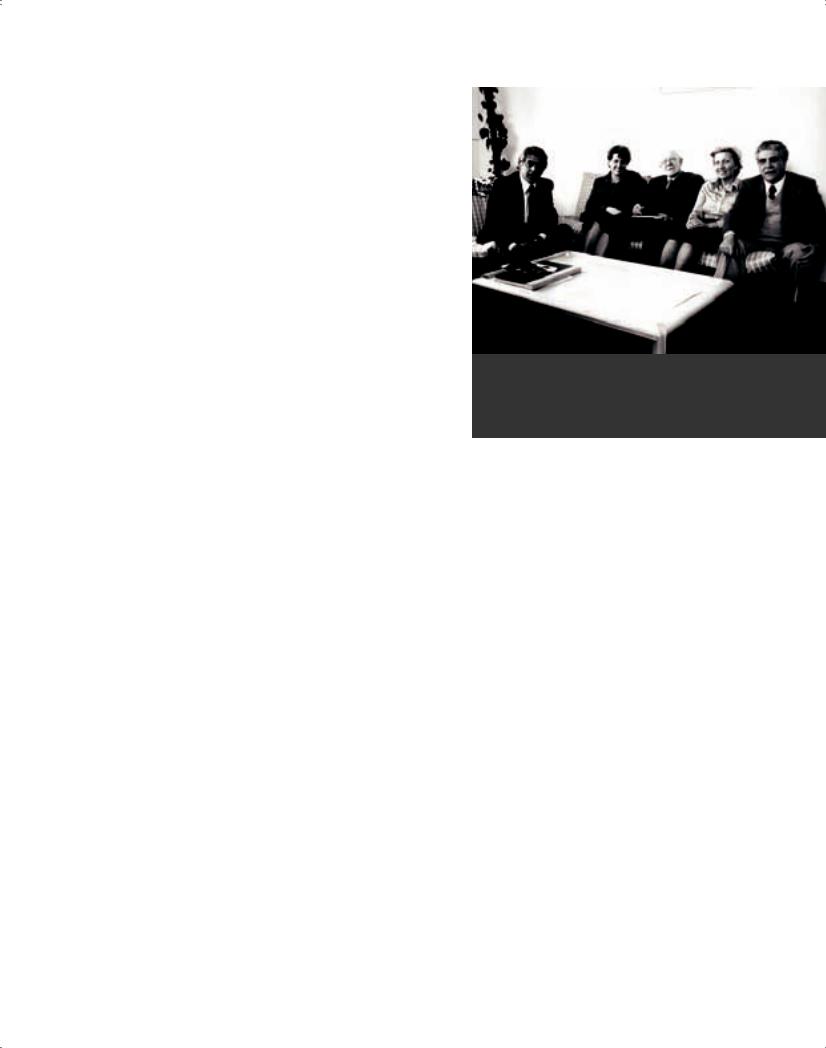
they had their feet firmly on the ground.”
The Statutes of the Centre also allowed for Associate Members to be admitted. Article 3 of the Statutes stated:
“The following shall be eligible for Associate Membership of the Centre:
• public or private institutions of a scientific or cultural nature of States which are not members of UNESCO. Admission to Associate Membership shall be on the recommendation of the Executive Board of UNESCO and by decision of the Council of the Centre taken by a two-thirds majority,
•public or private institutions of a scientific or cultural nature of those Member States or Associate Members of UNESCO. Admission to Associate Membership shall be by decision of the Council of the Centre taken by a two-thirds majority.”
The first Associate Members, as listed in 1969, included the following: National Gallery of Victoria (Australia), Calouste Gulbenkian Foundation (Portugal), Institut Suisse pour l’Etude de l’Art, International Institute for Conservation (IIC), Vatican Museum, Lerici Foundation (Italy), and the Museu de Arte Contemporanea da Universidade de São Paulo (Brazil).
Personnel
Regarding personnel, Fiammetta Varese Gamba retired as Librarian as from 1 October 1964. The staff then consisted of the Director and Deputy Director, plus five persons seconded by the Italian Government. But in the years 1965-1970 several new members were added so that by the end of the decade the personnel had doubled to 15.
Gertrude Tripp has recalled the personnel of the Centre at that period:71
“Looking back at the organization of the Rome Centre, we were lucky to have persons like the Director Harold Plenderleith and Paul Philippot, who was his deputy. Plenderleith was a very reasonable person, who understood the realities. He was easily accessible at the personal level, not complicated. Philippot … had the professional contacts through his father. For him, naturally, important was the ‘fine art’, and what his father had done was already on the highest level of restoration at the time. Philippot was extremely capable; he wrote all the documents, and summarized the discussions giving them a clear format. Of course, he already had the background of his farther, and he was in close
Figure 3 7
Early personnel of ICCROM: Natalino Proietti (driver), Gemma Berardinelli (secretary), H.J. Plenderleith (Director), Elena Fiorini (secretary) and Antonio Tito (warden)
collaboration with Paolo and Laura Mora and Cesare Brandi. He also came from the practice, which was very valuable. He was really a very clever person, very capable. At the same time, Philippot had so many human qualities. I must say that they were all exceptional people. These first ten years were really fantastic. I must say that I have never had so much inspiration in all my life as I had at ICCROM at the beginning. This included also my contacts with the Istituto Centrale del Restauro. This experience gave me the standpoint for the profession of a restorer.”
Premises
The offices of the Rome Centre were on the first floor of a 19th-century building at via Cavour 256, next to the Istituto Centrale del Restauro. Being adjacent to the ICR was important for both organizations and facilitated the exchange of information and collaboration. Indeed, often when the Centre had visitors, it was normal to take them to visit the ICR conservation studios, where they were received by the Director, Cesare Brandi, and the principal specialists, including particularly Laura Sbordoni-Mora and Paolo Mora. In an interview, Laura Mora expressed her delight with the arrival of the Centre in Rome: “Che bellezza! Finally! Because we are contrary to provincialism. A national institute is nothing and isn’t useful for anything if it’s not part of an international context. At my age, I’m still interested in foreign politics. With my own interest. It’s not
26 |
ICCROM and the Conservation of Cultural Heritage. A history of the Organization’s first 50 years, 1959-2009 |
|
|
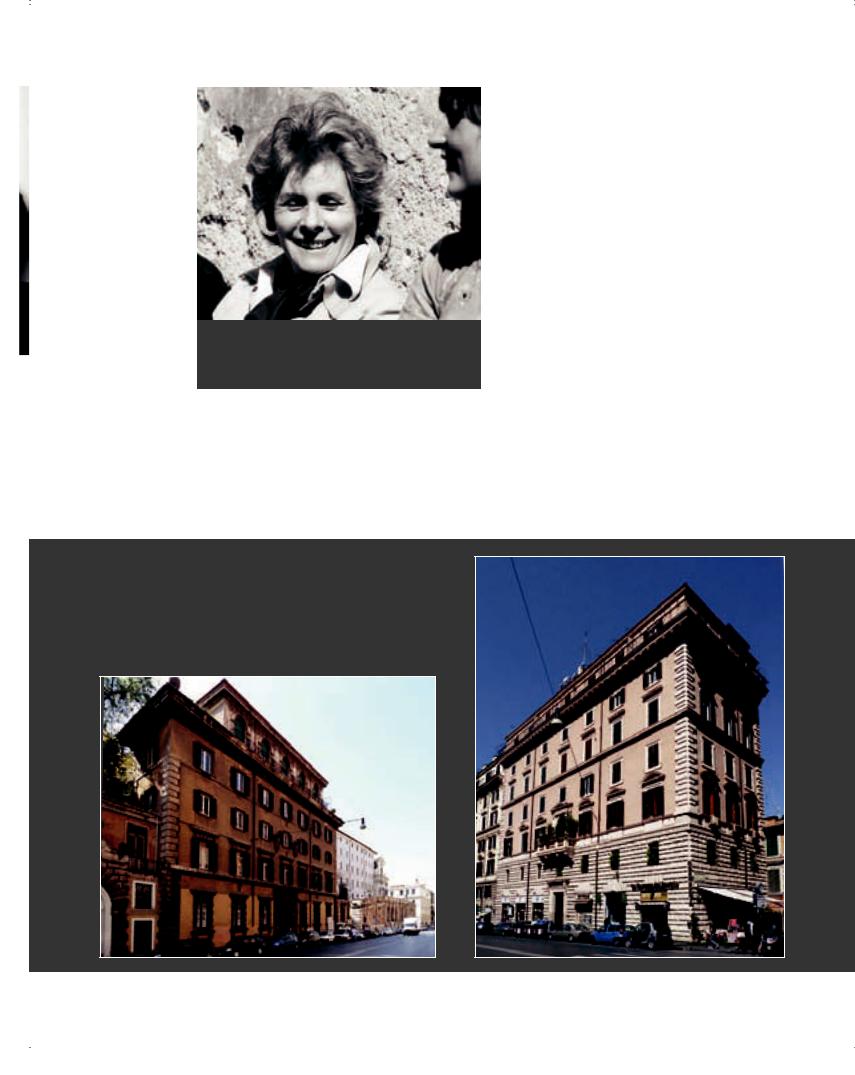
Figure 3 8
Laura Sbordoni-Mora, Chief Conservator of ICR and co-director of the Mural Paintings Course at ICCROM
enough for me to know what’s happening in Italy if I don’t know what’s happening in the world. You must always have a general standpoint.”72
In order to have space for the laboratory and didactic activities, the Centre signed a contract
on 1 August 1965 to rent additional premises in via Cavour 221, opposite the other building. These included a lecture room for 30 persons and provisional laboratory space. UNESCO provided the equipment and essential laboratory furniture.73 These premises were extended from 1 February 1970 by adding an apartment on the fourth floor with two classrooms and equipment for simultaneous translation.74 At the same time, negotiations were underway to find a larger space for the Centre in the future.
Planning of activities
In the first years, a large part of the work of the Centre, including missions and scientific consultations, was undertaken in collaboration with or at the request of UNESCO. At the same time, a close collaboration with ICOM effectively underlay the entire programme of activities. Indeed, Plenderleith was President of the ICOM Committee for Museum Laboratories and Philippot its secretary. As a result, the Centre could benefit from the professional collaboration of a large number of specialists. For example, the joint ventures included
Figure 3 9 (below)
Via Cavour 256: ICCROM’s director’s office, secretariat and library (first floor), vacated in 1973
Figure 3 10 (right)
Via Cavour 221: ICCROM’s premises for training and laboratory (3rd and 5th floors), vacated in 1972
|
|
|
|
|
|
|
3 The Rome Centre (1960-1970) |
27 |
|
|
|

a number of reports produced in agreement with the Committee for Museum Laboratories (at meetings in 1961 and 1962) regarding the conservation of textiles (L. Bellinger), paper (F. Flieder, L. Santucci), manuscripts (F. Flieder), stone (R. Sneyers), metal (R. Organ, R.J. Gettens), wood (N. Brommelle), musical instruments (N. Brommelle), mural paintings (P. Mora), and conservation in tropical and subtropical climates (P. Coremans, H.J. Plenderleith). It also collaborated with the IIC, which held its first General Conference in Rome in September 1961. Some 150 people attended this international conference, held with the help of a grant from the Gulbenkian Foundation in collaboration with the Centre. Papers from it were published by Butterworths under the title Recent Advances in Conservation.75
In 1965, the Director of the Centre was able to report to the third session of the General Assembly:
“The importance of the new adhesions to the Centre that have been made during the last two years makes it possible today to view the future in more optimistic and above all more positive terms than at the time of the two first General Assemblies. This in no way means that the Centre has attained a point of equilibrium on which it can stabilize itself. The problems of development on the contrary remain fundamental, as much on the financial as organizational plane, and if one can so express it, as regards doctrine. But for the first time, it is possible to approach, in a realistic way, the aims of the Centre, - those defined in its Statutes – and its means to realize the main principles of a coherent policy of activity and development.
The moment has come to examine, from this point of view, the situation of the preservation of cultural property throughout the world, so as to define the role that the Centre must play in response to the necessity which justified its creation. The past 6 years have shown in detail the different aspects of this situation, their importance and relative urgency and their rapid evolution. Indeed, some considerable changes have taken place in the world situation since the time when the Centre was conceived.
It has become evident in all countries, and particularly in those in the process of rapid transformation, that the most urgent problem and the most serious is less that of research than that of the organization of teams of specialists who would be able to carry out the treatments currently used in the most recommended institutes, in any part of the world where works might require it. In response to
these needs organizations are being formed, whose creation is supported by UNESCO, and to this end New Delhi, Jos, Mexico have been encouraged to establish regional centres of training. On the other hand institutes already well established such as the Institut Royal du Patrimoine Artistique in Brussels and the Istituto Centrale del Restauro in Rome are opening their doors ever wider to young foreigners wishing to specialize or attend training courses or cycles of courses. Finally a new international non-govern- mental organization is in the process of creation, which will constitute for the vast section of historic monuments what ICOM is for the world regarding museums.
All these initiatives are by way of being efforts to respond to the urgency, the vastness and the variety of problems arising in connexion with the preservation of cultural property. But the Centre would be failing in its duty if it did not draw attention to the dangers of a prolification of good intention which are not guided by a clear vision of the whole of the situation. In order that these initiatives should bear the maximum fruit they must be introduced, at international level, into a general policy which will be co-ordinated in order to ensure the full efficacy of each and all. Their individual organic relationships each to the other must be worked out and defined. An effort to rationalize the situation is necessary. It is the condition on which any coherent policy of the Centre’s activities and developments depends.”76
As a follow-up proposal to the fourth General Assembly in 1967, the Centre’s secretariat prepared a draft Project for the Long-term Development of the Centre’s Activities Should its Income be Increased.77
Taking into account the Assembly’s comments, another document was prepared for the fifth General Assembly in 1969: Policy for the Activities of the Centre.78
Proposed long-term programme (1966)
The 1966 Project for the Long-term Development document indicated that, on the basis of a worldwide survey of the needs in the field of the conservation of cultural heritage, conducted by the Centre’s staff since 1959, the most urgent need in nearly every country was “for the training of specialists in all types of restoration work.” Furthermore, it considered it essential to be able to send specialists quickly to places where help was needed. Finally, the Centre’s had to develop in a systematic manner its
28 |
ICCROM and the Conservation of Cultural Heritage. A history of the Organization’s first 50 years, 1959-2009 |
|
|

documentation, which formed the basis for its information. As a result, it was proposed that the Centre’s activities be developed along three main lines:
•Training of specialists in conservation
•Development of documentation
•Missions by experts
Other activities, such as publications and meetings of specialists, would be normally financed from the Centre’s pro-rata income, i.e. income from Member States’ contributions.
Training of specialists in conservation
Principles followed by the Centre
The training of museum personnel was the theme of the ICOM General Conference in New York in 1965. Paul Coremans presented a report there on an international policy for the training of specialists in conservation, based on a survey of the situation. The Centre accepted the main argument of this report which was supported by the experience gained in courses organized by ICR and IRPA. Training for restoration of objects of all kinds was probably the least organized of all. Nearly everywhere such work was done by more or less competent craftsmen. Systematic training was available in only a few places, such as Nancy (for metals), Faenza (for ceramics), New York at the NYU Conservation Centre, the University of London and IRPA in Brussels. Based on the surveys, the Centre formulated principles to be followed in future programmes. It proposed that basic training should be offered at both national and regional levels. As a matter of fact, UNESCO was already creating Regional Centres (e.g. at New Delhi in India, at Jos in Nigeria and in the ex-convent of Churubusco in Mexico City) which could provide such basic training and also help select suitable candidates for international courses. At the international level, priority should be given to more advanced training, and it is there that the Centre could most usefully participate. Such training should best be organized in collaboration with specialized institutions which could provide teaching faculty and by invitation to foreign specialists at the Centre’s expense. Practical work experience should be part of the training.
Requirements for training
In order to be able to guarantee suitable conditions for training, the Centre needed suitable premises. It needed teaching equipment and technical services, such as simultaneous translation, projection and recording. The Centre should progressively adapt its laboratory for teaching purposes, and provide equipment for site work. A systematic policy for scholarships should be defined in collaboration with UNESCO. Regarding the teaching staff, the general
idea would be to employ under contract outside help, rather than increasing the Centre’s personnel – though some additional staff would be necessary.
Courses envisaged
The realization of the training programme should be progressive and adapted to the Centre’s means and immediate requirements. There were various courses proposed: a course on the Conservation of Monuments, to be organized in collaboration with Rome University lasting 30 weeks, and offering some 220 hours of lectures; a course in collaboration with the Office of the Director General of the Department of Antiquities, Ministry of Education, addressing leading field technicians for monuments or excavations (20 weeks); a course on the restoration of paintings and sculptures jointly with ICR (20-30 weeks); and other courses in the conservation of objects for laboratory technicians at different levels of qualification. Suitable institutions still needed to be found or else it was proposed to develop appropriate facilities at the Centre’s laboratory.79
Development of the Centre’s documentation
Regarding the development of a strategy for documentation, the Centre invited a technical report from Yvonne Oddon of the UNESCO/ICOM Documentation Centre and Robert Didier, Librarian of IRPA. Their report highlighted six urgent needs at the Centre:
1.Systematic development and analysis of the collection of reprints and photocopies;
2.Card index to be organized following the system used by the Laboratory in Amsterdam;
3.Collection and distribution of technical notes in collaboration with specialized institutions, indicating products used for restoration (composition, trademarks, suppliers, recipes, equipment, pigments);
4.Detailed card index of specialists in conservation;
5.Card index of institutions specialized in conservation, updating the existing Museum Repertory;
6.Systematic abstraction of periodicals received by the Library.
To accomplish these tasks, it was necessary to provide additional salary for the librarian, to hire a documentalist, and to acquire the necessary equipment. Furthermore, some US $2 500 per annum would be needed for acquisition of books and other material, starting from 1968 when a grant from the Gulbenkian Foundation would have ended.
3 The Rome Centre (1960-1970) |
29 |
|
|
